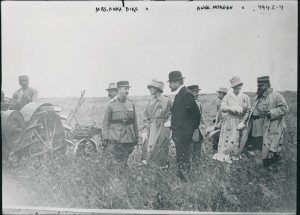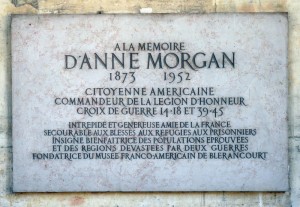
Anne Murray Dike, Fernand David, and Anne Morgan with French soldiers. © Washington, Library of Congress
American Volunteers
Anne Tracy Morgan
Anne Tracy Morgan (1873-1952) became one of the richest heiresses in the world when her father, the great financier John Pierpont Morgan died in 1913. In 1907, she stayed in France at the luxurious Villa Trianon in Versailles, with Elizabeth Marbury (1856-1933) and Elsie de Wolfe (1865-1950).
At the end of September 1914, the three women returned to the United States to collect funds destined to the wounded in the European War. With Elizabeth Lathrop, they founded the American Fund for French Wounded (AFFW) to provide relief to field hospitals, ambulance services and packages for French wounded soldiers. Between 1915 and 1916, Anne Morgan and Elsie de Wolfe transformed the Villa Trianon into a military convalescent hospital.
Volunteer Relief for Civilians
Following the entry of the United States into the War in 1917, Anne Morgan moved to the ruins of Château Blérancourt in the Aisne with the authorization of French authorities. In 1918, the Civilian Section of the American Fund for French Wounded became the American Committee for Devastated France (ACDF) – In French known as CARD: Comité Américain pour les Régions Dévastées. The volunteer organization was involved in many differents areas such as healthcare, housing, education and leisure activities.
Volunteers from different nationalities were required to speak French and hold a driver’s certificate, had to purchase their own blue uniform and pay for their own expenses. These visiting nurses and drivers-mechanics could be seen driving in Ford Model T and Dodge Delivery Trucks as they reached out to the French population living in devastated areas, offering relief (miscellaneous utensils, agricultural equipment or livestock) and advice, and more particularly so to the children in need for wholesome food, clothing, and medical care. They created major long term educational initiatives in the forms of schools (carpentry, housekeeping), libraries and socializing (drama groups, film-clubs) leaving an enduring legacy in the region.
Rebuilding Devastated France
Three years of war and intense shelling had left the hardest-hit regions in a state of ruins. Buildings, bridges, roads were so damaged that they had to be demolished so that they may be rebuilt. The French authorities sent wooden barracks, the so-called “provisoire”, temporary prefab structures that came out of factories to be assembled for housing a family, a school, a church or a warehouse. Volunteers in the American Committee for Devastated France continued their relief work and live in these barracks until they were all replaced by permanent buildings.
Remembrance
In 1924, Anne Morgan dissolved the American Committee for Devastated France and bought the Château de Blérancourt where she founded the Historical Franco-American Museum that became the Museum of Franco-American Cooperation of Blérancourt in 1931. This museum that holds remarkable collections closed for renovation is due to reopen to the public during the year.



Ajouter un commentaire